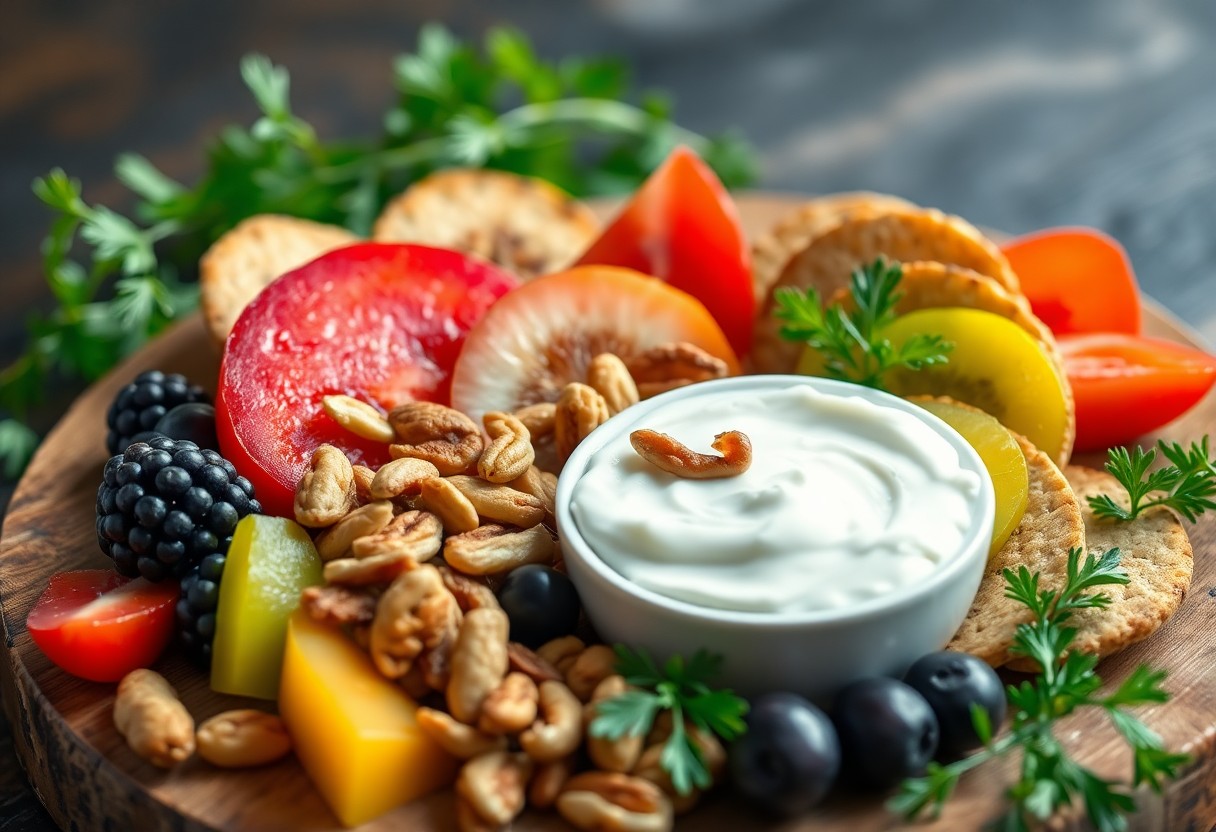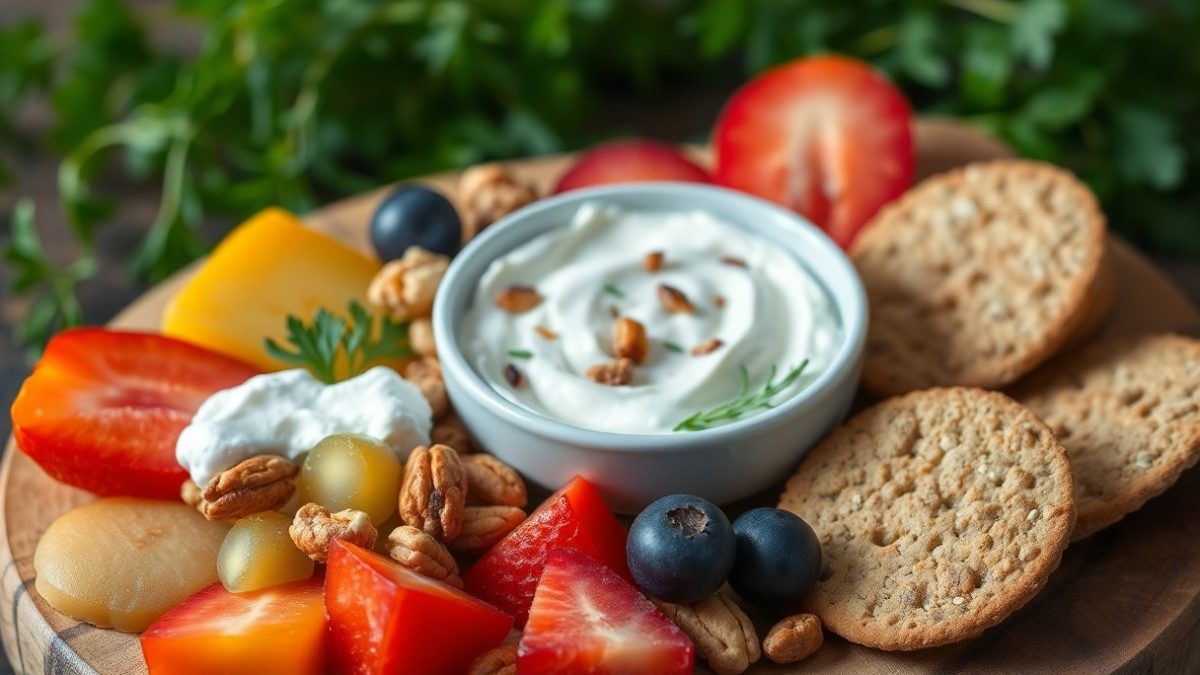Balancing Flavor And Nutrition In Healthy Snack Choices

Top Healthy Snack Pairings For Ultimate Flavor And Health
November 7, 2024
10 Easy Family Meals Everyone Will Love This Week
November 8, 2024Snacks are often seen as the guilty pleasure that can disrupt your healthy eating habits, but they don’t have to be. You can make smart choices that satisfy your cravings while also providing important nutrients. By finding the right mix of flavorful and nutritious ingredients, you can turn your snack time into an opportunity for better health. This post will guide you through the process of selecting snacks that not only taste great but also contribute positively to your overall well-being.
Key Takeaways:
- Diverse Ingredients: Incorporating a variety of nutrient-dense ingredients can enhance both flavor and health benefits in snacks.
- Natural Sweeteners: Using natural sweeteners like honey or maple syrup can satisfy sweet cravings while maintaining lower nutritional impact compared to refined sugars.
- Portion Control: Balancing portion sizes helps manage caloric intake, allowing for flavorful snacks that do not compromise nutritional goals.

Understanding Nutritional Needs
For optimal health and well-being, it’s important to understand your nutritional needs, which vary based on factors like age, activity level, and individual health conditions. By identifying your specific requirements, you can make informed choices about snacks that provide both taste and nourishment, ensuring you are supporting your body’s functions effectively while satisfying your cravings.
Macronutrients vs. Micronutrients
Against the backdrop of nutrition, it’s important to distinguish between macronutrients and micronutrients. Macronutrients—carbohydrates, proteins, and fats—are important for providing energy, while micronutrients—vitamins and minerals—support various biochemical processes in your body. Therefore, finding the right balance of both is key to maintaining overall wellness.
The Role of Fiber and Protein
Among the many nutritional elements, fiber and protein play significant roles in your diet. Fiber aids in digestion and fosters a feeling of fullness, which can help manage appetite and weight. High-protein snacks not only help you feel satiated but also support muscle repair and growth. Incorporating both into your diet can enhance your overall health, making you feel energized and satisfied.
Even more, fiber is known to promote gut health by improving digestion and regulating blood sugar levels, while protein is vital for several bodily functions, including enzyme production and hormone regulation. Prioritizing snacks rich in both will not only keep you fuller for longer but also strengthen your metabolism and support your immune system. By efficiently including fiber and protein in your diet, you can enjoy tasty snacks that also contribute positively to your well-being.
The Importance of Flavor in Snacks
The significance of flavor in snacks cannot be overstated, as it serves as a primary motivator for your choices. A well-flavored snack enhances your eating experience, making it more enjoyable and satisfying. When you opt for healthy options, the flavor becomes even more crucial, bridging the gap between indulgence and nutrition. You are more likely to reach for snacks that tantalize your taste buds, ensuring that maintaining a healthy diet doesn’t feel like a chore.
Psychological Impact of Taste
Around the world, taste influences your preferences and emotional state. When you enjoy the flavors of your snacks, it leads to feelings of happiness and contentment, encouraging you to make better food choices. This positive association can also boost your motivation to indulge in healthier options, as you learn to connect nutritious ingredients with enjoyable experiences.
Balancing Sweet and Savory
Balancing flavors is crucial when selecting healthy snacks, particularly when it comes to combining sweet and savory elements. This harmony not only pleases your palate but also ensures you feel satisfied longer. When you incorporate both flavor profiles, you can avoid cravings for unhealthy alternatives, and you may discover that the right balance enhances your overall eating experience.
Savory treats often contain umami, a taste that can keep you content, while sweet flavors satisfy your need for energy and indulgence. By carefully choosing snacks that blend these two profiles, you can enjoy bursts of flavor without excessive sugar or unhealthy fats. For instance, options like dark chocolate-covered almonds or sweet potato chips provide a delightful mix that can keep your appetite at bay while still delivering crucial nutrients. This balance is vital for maintaining a healthy lifestyle while enjoying what you eat.
Identifying Healthy Snack Options
Not all snacks are created equal, and identifying healthy options is key to balancing flavor and nutrition. Look for snacks that incorporate whole ingredients and provide a good mix of macronutrients. For ideas on how to make better choices, check out How to Build Balanced Snacks + 40 Snack Ideas from a Registered Dietitian.
Whole Foods vs. Processed Snacks
Before choosing a snack, consider whether it consists of whole foods or processed ingredients. Whole foods like fresh fruits, vegetables, nuts, and whole grains offer more nutrients and beneficial compounds. In contrast, processed snacks often contain additives, preservatives, and unhealthy fats, making them less favorable for your health.
Reading Nutrition Labels
On your journey to healthier snacking, it’s important to understand how to read nutrition labels effectively. Look for products that are low in added sugars, unhealthy fats, and sodium. Additionally, pay attention to serving sizes to avoid overeating. Understanding calories, ingredients, and nutritional information will empower you to make better choices. This knowledge helps you distinguish between snacks that might seem healthy but are actually low in nutrients.
To maximize your ability to choose healthier snacks, focus on the nutrition label’s calories, added sugars, and saturated fats. Be wary of items that list sugar among the first few ingredients, as this usually indicates a high content. Look for a short ingredient list—more whole foods generally means better nutrition. Pay attention to fiber content as well; higher fiber snacks are often more filling and nutritionally beneficial. Taking the time to scrutinize labels lets you enjoy treats without sacrificing health.
Creative Ideas for Healthy Snacks
Your journey to healthier snacking can be both exciting and delicious! By exploring creative ideas for snack options, you can discover a variety of flavors and textures that not only satisfy your cravings but also nourish your body. From fruity treats to savory bites, embracing creativity in your snack choices allows you to keep things interesting and enjoyable while making informed health decisions.
DIY Snack Recipes
About crafting your own snacks is a rewarding way to ensure you know exactly what you’re eating. Simple recipes such as homemade energy balls using oats, nut butters, and your favorite seeds or dried fruits can keep you energized throughout the day. Additionally, creating savory roasted chickpeas seasoned with your favorite spices is another quick and nutritious snack option.
Pairing Ingredients for Optimal Flavor
Around exploring flavor pairings can elevate your snacking experience while providing important nutrients. Combining ingredients like avocado with whole-grain crackers not only satisfies your taste buds but also enhances heart health with healthy fats. Complementing yogurt with berries and a sprinkle of nuts adds both flavor and crucial antioxidants.
Ideas for ingredient pairing can transform ordinary snacks into culinary delights. For example, try mixing nut butter with banana slices for a sweet yet protein-packed treat. Alternatively, consider the dynamic duo of dark chocolate and almonds: the rich chocolate satisfies your sweet tooth while the almonds deliver fiber and healthy fats. Experimenting with different combinations can lead to unique flavors that make healthy snacking enjoyable and satisfying.
Overcoming Common Snacking Challenges
Unlike indulgent snacks that may leave you feeling guilty, healthy snacking can sometimes present challenges such as managing cravings and controlling portion sizes. With a bit of strategy, you can tackle these obstacles effectively, ensuring that your snack choices are both satisfying and nourishing. By understanding your triggers and employing mindful eating techniques, you can enjoy a balanced approach to snacking without sacrificing flavor.
Managing Cravings
At times, you may find yourself grappling with intense snack cravings, which can lead to impulsive food choices. To help combat these urges, focus on staying hydrated and incorporating protein and fiber into your meals, as these nutrients can help keep you fuller for longer. Additionally, recognize that cravings often stem from emotional triggers, and finding healthier alternatives can help satisfy your hunger without compromising your nutrition goals.
Strategies for Portion Control
Snacking wisely means understanding portion control to avoid mindless overeating. By serving your snacks in small, pre-portioned amounts, you can better manage your intake while still enjoying your favorite healthy treats. This could involve using snack-sized containers or measuring out single servings before sitting down to indulge. You’ll find that controlling portion sizes allows you to appreciate the flavors and textures of your snacks without the risk of overindulgence.
Cravings can lead to emotional or unhealthy eating if you’re not paying close attention. Instead, assess your feelings and identify whether you’re genuinely hungry or just looking for comfort. Keeping healthy snacks on hand makes it easier to respond to cravings with nutritious choices rather than processed options. You can also try engaging in a quick physical activity to distract yourself momentarily. Prioritizing mindful eating will not only help you control impulses but also enhance your overall snacking experience.
The Role of Mindfulness in Snacking
Once again, snacking can be a mindful experience that enhances your connection to both flavor and nutrition. By being present and attentive during snack time, you not only enjoy your food more but also make choices that align with your health goals. Practicing mindfulness can help you recognize cravings and select snacks that genuinely satisfy your needs, ultimately fostering a balanced approach to eating that supports your overall well-being.
Eating with Intention
Across your snacking habits, adopting an intentional mindset can transform your relationship with food. Instead of reaching for snacks out of habit or boredom, take a moment to consider what you truly want and need at that moment. This mindful approach allows you to choose snacks that not only satiate your hunger but also nourish your body, making each bite more enjoyable and beneficial.
Listening to Body Signals
At times, you may find it challenging to discern whether you’re truly hungry or simply bored. Tuning into your body’s signals is vital to understanding your needs better, allowing you to differentiate between physical hunger and emotional cravings. By paying close attention to how your body feels before snacking, you can make more informed decisions about what to eat and when to eat it.
Also, developing the ability to listen to your body can lead to a more balanced snacking routine. Notice physical indicators such as rumbling stomach, low energy, or cravings to determine your true needs. It’s vital to recognize that emotional eating can mask genuine hunger, making it vital to check in with yourself during snack times. By being attentive to these signals, you’ll be better equipped to choose snacks that truly satisfy your hunger, enhance your well-being, and contribute to your overall health goals.
Summing up
Taking this into account, balancing flavor and nutrition in your healthy snack choices is important for maintaining well-being without sacrificing enjoyment. By selecting options that excite your taste buds while also offering nutritional benefits, you can create satisfying snacks that fuel your body and mind. Prioritize whole ingredients, explore diverse flavors, and find ways to incorporate protein, fiber, and healthy fats into your snacks. Doing so will empower you to make mindful choices that contribute to your overall health while still indulging your cravings.
FAQ
Q: How can I ensure that my healthy snacks are flavorful?
A: To make your healthy snacks more flavorful, consider incorporating a variety of herbs and spices. Ingredients like cinnamon, paprika, or cumin can elevate the taste without adding extra calories. Additionally, combining textures can also enhance flavor; for instance, pairing creamy yogurt with crunchy nuts or seeds can create a satisfying experience. Experimenting with different preparation methods, such as roasting or grilling, can also bring out unique tastes in vegetables or proteins.
Q: What are some examples of nutritious snacks that don’t compromise on taste?
A: There are plenty of tasty options that pack nutritional benefits. For example, homemade energy bites made from oats, nut butter, and a touch of honey deliver both energy and flavor. Greek yogurt topped with fresh fruits and a sprinkle of granola is another great choice, combining protein with natural sweetness and crunch. Additionally, apple slices dipped in almond butter or whole-grain crackers paired with hummus can provide a satisfying balance of sweetness and savory flavors.
Q: How can I make healthy snacks more appealing to kids?
A: To make healthy snacks more appealing to kids, try involving them in the preparation process. Organizing a “build-your-own” snack bar, where they can choose toppings and mix ingredients, makes it fun and engaging. Presenting snacks in colorful, artistic ways—like fruit kebabs or a rainbow vegetable platter—can also pique their interest. Furthermore, incorporating dips, such as yogurt or guacamole, can enhance the experience and encourage kids to try new options.
NEWSLETTER







